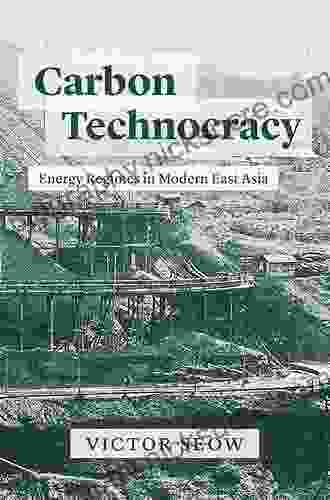Energy Regimes in Modern East Asia: Studies of the Weatherhead East Asian Institute

Abstract
This article explores the diverse energy regimes in modern East Asia, examining their historical development, current challenges, and future prospects. Drawing on research from the Weatherhead East Asian Institute at Columbia University, the article analyzes the energy policies, technologies, and markets that shape the region's energy landscape. It highlights the role of state actors, market forces, and societal factors in shaping energy governance and consumption patterns. The article concludes by discussing the implications of these energy regimes for regional cooperation, environmental sustainability, and economic development.
Energy is a critical input for economic growth, social development, and environmental sustainability. East Asia, home to some of the world's fastest-growing economies, is undergoing a significant energy transition, driven by a combination of economic growth, urbanization, and environmental concerns. The region's energy regimes, which include the mix of energy sources, technologies, and policies, are diverse and reflect the varying economic, political, and social contexts of East Asian countries.
5 out of 5
| Language | : | English |
| File size | : | 20970 KB |
| Text-to-Speech | : | Enabled |
| Screen Reader | : | Supported |
| Enhanced typesetting | : | Enabled |
| Print length | : | 412 pages |
| Lending | : | Enabled |
This article examines the energy regimes in modern East Asia, drawing on research from the Weatherhead East Asian Institute at Columbia University. The article analyzes the historical development, current challenges, and future prospects of these energy regimes, focusing on the role of state actors, market forces, and societal factors in shaping energy governance and consumption patterns. The article concludes by discussing the implications of these energy regimes for regional cooperation, environmental sustainability, and economic development.
Energy Policies and Technologies
East Asian countries have adopted a range of energy policies and technologies to meet their growing energy needs. These policies and technologies vary widely across the region, reflecting differences in resource endowments, economic development levels, and environmental priorities.
China, the region's largest economy, is the world's largest consumer and producer of energy. China's energy policy has traditionally focused on securing energy supplies to support its rapid economic growth. In recent years, China has made significant investments in renewable energy and energy efficiency, aiming to reduce its dependence on fossil fuels and address its environmental challenges.
Japan, another major energy consumer, has a long history of energy security concerns due to its lack of indigenous energy resources. Japan's energy policy has emphasized energy diversification, including the development of nuclear power and renewable energy sources. After the Fukushima Daiichi nuclear disaster in 2011, Japan has shifted its energy policy towards a greater reliance on renewable energy and energy efficiency.
South Korea, a rapidly industrializing economy, has also focused on energy security and diversification. South Korea's energy policy has emphasized the development of nuclear power and renewable energy sources, as well as the import of liquefied natural gas (LNG).
Southeast Asian countries, such as Indonesia, Malaysia, and Thailand, have abundant natural gas and coal resources. These countries have traditionally relied on these fossil fuels to meet their energy needs. However, in recent years, these countries have also begun to invest in renewable energy and energy efficiency, aiming to reduce their dependence on fossil fuels and address their environmental challenges.
Market Forces and Energy Governance
Market forces play a significant role in shaping energy regimes in East Asia. The region's energy markets are characterized by a mix of state-owned and private companies, as well as a growing number of independent power producers (IPPs).
In China, the state-owned energy sector remains dominant, although private companies are playing an increasing role in the development and operation of renewable energy projects. In Japan, the energy market is dominated by a few large utilities, but IPPs are gaining market share in the renewable energy sector. In South Korea, the energy market is more diversified, with a mix of state-owned, private, and IPP companies.
Southeast Asian energy markets are characterized by a mix of state-owned and private companies, as well as a growing number of IPPs. In Indonesia, the state-owned energy sector dominates the upstream oil and gas sector, but private companies play a significant role in the downstream sector. In Malaysia, the state-owned energy company Petronas plays a dominant role in the energy sector, but private companies are also active in the downstream sector. In Thailand, the energy market is more diversified, with a mix of state-owned, private, and IPP companies.
The role of market forces in shaping energy regimes in East Asia is likely to increase in the future. As the region's energy demand continues to grow, governments are likely to rely more on the private sector to finance and develop energy projects.
Societal Factors and Energy Consumption
Societal factors, such as cultural values, social norms, and lifestyle choices, also influence energy consumption patterns in East Asia.
In China, the traditional emphasis on economic growth has led to a high demand for energy. Chinese consumers are also increasingly adopting energy-intensive lifestyles, such as owning cars and using air conditioning.
In Japan, the traditional emphasis on energy conservation has led to lower levels of energy consumption per capita than in other developed countries. Japanese consumers are also more likely to adopt energy-efficient technologies and practices.
In South Korea, the rapid pace of economic development has led to a high demand for energy. South Korean consumers are also increasingly adopting energy-intensive lifestyles, such as owning cars and using air conditioning.
Southeast Asian countries, such as Indonesia, Malaysia, and Thailand, have traditionally had lower levels of energy consumption per capita than developed countries. However, as these countries develop economically, energy consumption is likely to increase.
The role of societal factors in shaping energy consumption patterns in East Asia is likely to continue in the future. As the region's economies continue to grow and lifestyles change, energy consumption is likely to increase.
Implications for Regional Cooperation, Environmental Sustainability, and Economic Development
The diverse energy regimes in East Asia have implications for regional cooperation, environmental sustainability, and economic development.
In terms of regional cooperation, the need for energy security and the growing demand for energy resources are driving East Asian countries to cooperate on energy issues. For example, China and Japan are cooperating on the development of LNG projects in Russia. Southeast Asian countries are also cooperating on energy issues, such as the development of a regional power grid.
In terms of environmental sustainability, the high demand for energy in East Asia is putting a strain on the region's environment. Air pollution, water pollution, and climate change are major challenges facing the region. East Asian countries need to cooperate on developing and implementing sustainable energy policies to address these challenges.
In terms of economic development, the availability of affordable and reliable energy is essential for economic growth. East Asian countries need to ensure they have the energy resources and infrastructure to support their economic development.
Energy regimes in modern East Asia are diverse and reflect the varying economic, political, and social contexts of the region's countries. These energy regimes are undergoing a significant transition, driven by a combination of economic growth, urbanization, and environmental concerns. The role of state actors, market forces, and societal factors in shaping energy governance and consumption patterns is complex and evolving.
The implications of these energy regimes for regional cooperation, environmental sustainability, and economic development are significant. East Asian countries need to cooperate on energy issues to address the challenges of energy security, environmental sustainability, and economic development.
5 out of 5
| Language | : | English |
| File size | : | 20970 KB |
| Text-to-Speech | : | Enabled |
| Screen Reader | : | Supported |
| Enhanced typesetting | : | Enabled |
| Print length | : | 412 pages |
| Lending | : | Enabled |
Do you want to contribute by writing guest posts on this blog?
Please contact us and send us a resume of previous articles that you have written.
 Fiction
Fiction Non Fiction
Non Fiction Romance
Romance Mystery
Mystery Thriller
Thriller SciFi
SciFi Fantasy
Fantasy Horror
Horror Biography
Biography Selfhelp
Selfhelp Business
Business History
History Classics
Classics Poetry
Poetry Childrens
Childrens Young Adult
Young Adult Educational
Educational Cooking
Cooking Travel
Travel Lifestyle
Lifestyle Spirituality
Spirituality Health
Health Fitness
Fitness Technology
Technology Science
Science Arts
Arts Crafts
Crafts DIY
DIY Gardening
Gardening Petcare
Petcare Linda Carroll
Linda Carroll Buddy Levy
Buddy Levy Elizabeth Lockwood
Elizabeth Lockwood Candice Davie
Candice Davie Carlo Collodi
Carlo Collodi Kate Williams
Kate Williams John Aldridge
John Aldridge Helen Fisher
Helen Fisher Shmuel Peerless
Shmuel Peerless Patrick Sweeney
Patrick Sweeney Christine Kenneally
Christine Kenneally Barbara Kennard
Barbara Kennard Dacher Keltner
Dacher Keltner Monica Hesse
Monica Hesse Victor Seow
Victor Seow Steve Biddulph
Steve Biddulph Otto Scharmer
Otto Scharmer Barbara Neiman
Barbara Neiman Rachel Dash
Rachel Dash Ryan A Pedigo
Ryan A Pedigo Eugene V Resnick
Eugene V Resnick Laura Ingalls Wilder
Laura Ingalls Wilder Rebecca Rupp
Rebecca Rupp John Quick
John Quick Vincent Bossley
Vincent Bossley Barry Burd
Barry Burd Oliver T Spedding
Oliver T Spedding J Bruce Brackenridge
J Bruce Brackenridge Conor Nolan
Conor Nolan Bonnie Tsui
Bonnie Tsui Justin Sirois
Justin Sirois W Scott Elliot
W Scott Elliot Lynn Rosen
Lynn Rosen Colleen Alexander Roberts
Colleen Alexander Roberts Master Gamer
Master Gamer Larry Dane Brimner
Larry Dane Brimner Debra Kilby
Debra Kilby Donald Frias
Donald Frias Ben Goldacre
Ben Goldacre Jeffrey Jensen Arnett
Jeffrey Jensen Arnett Bruce Pascoe
Bruce Pascoe Susan Nance
Susan Nance Massimo Cossu Nicola Pirina
Massimo Cossu Nicola Pirina Gabriyell Sarom
Gabriyell Sarom Mark Twain
Mark Twain Eric Engle
Eric Engle Robert Hogan
Robert Hogan Daniel J Barrett
Daniel J Barrett Kit Yates
Kit Yates Jennifer Traig
Jennifer Traig Suzanne Leonhard
Suzanne Leonhard Spencer Wells
Spencer Wells David A Bogart
David A Bogart Mike Massie
Mike Massie David Abram
David Abram John Lister Kaye
John Lister Kaye Dr Craig Malkin
Dr Craig Malkin Isabel Fonseca
Isabel Fonseca Emma Walker
Emma Walker Jenny Chandler
Jenny Chandler V B Alekseev
V B Alekseev Hill Gates
Hill Gates Leon Mccarron
Leon Mccarron Robert A Baruch Bush
Robert A Baruch Bush Deanna Roy
Deanna Roy Scott Malthouse
Scott Malthouse Emma Brockes
Emma Brockes Arny Alberts
Arny Alberts Mark H Newman
Mark H Newman James Koeper
James Koeper Jen Houcek
Jen Houcek Charlotte Browne
Charlotte Browne Jonathan Bergmann
Jonathan Bergmann Jim Fay
Jim Fay Jaymin Eve
Jaymin Eve Peter K Tyson
Peter K Tyson Timothy Pakron
Timothy Pakron Barry Johnston
Barry Johnston Crystal Duffy
Crystal Duffy Becca Anderson
Becca Anderson David Beaupre
David Beaupre Marie Rutkoski
Marie Rutkoski Susan Dennard
Susan Dennard James C Radcliffe
James C Radcliffe Barbara Taylor
Barbara Taylor Gordon Witteveen
Gordon Witteveen Macauley Lord
Macauley Lord Lily Collins
Lily Collins Leonard M Adkins
Leonard M Adkins James Kilgo
James Kilgo Visual Arts
Visual Arts Catherine J Allen
Catherine J Allen Jenna Helland
Jenna Helland Edwin R Sherman
Edwin R Sherman Valerie Pollmann R
Valerie Pollmann R Constanze Niedermaier
Constanze Niedermaier Marshall Jon Fisher
Marshall Jon Fisher Jenn Mcallister
Jenn Mcallister Diane Musho Hamilton
Diane Musho Hamilton Denton Salle
Denton Salle Lynn Mann
Lynn Mann Nicholas Wolterstorff
Nicholas Wolterstorff Trish Kuffner
Trish Kuffner Catherine M Cameron
Catherine M Cameron Daniel M Koretz
Daniel M Koretz Jack Newman
Jack Newman Wanda Priday
Wanda Priday Chris Bennett
Chris Bennett William H Frey
William H Frey Scott Westerfeld
Scott Westerfeld Nadine Hays Pisani
Nadine Hays Pisani Nina Manning
Nina Manning Hongyu Guo
Hongyu Guo Max Marchi
Max Marchi Khurshed Batliwala
Khurshed Batliwala Jim Wharton
Jim Wharton Barbara Gastel
Barbara Gastel Jean Smith
Jean Smith Sam Nadler
Sam Nadler Charles Soule
Charles Soule Kate Darling
Kate Darling S E Hinton
S E Hinton Rhonda Belle
Rhonda Belle James Duthie
James Duthie Barbara Bassot
Barbara Bassot Michelle Rigler
Michelle Rigler David Jamieson Bolder
David Jamieson Bolder Prince Asare
Prince Asare Stephen K Sanderson
Stephen K Sanderson Erica B Marcus
Erica B Marcus Kara Goucher
Kara Goucher Jay Abramson
Jay Abramson Proper Education Group
Proper Education Group Rebecca Solnit
Rebecca Solnit Jonathan Kellerman
Jonathan Kellerman Ben Sedley
Ben Sedley Wayne B Chandler
Wayne B Chandler Debbie M Schell
Debbie M Schell Barzin Pakandam
Barzin Pakandam Temple West
Temple West Laura Pavlov
Laura Pavlov Siddhartha Rao
Siddhartha Rao Nick Neely
Nick Neely Nicole Martin
Nicole Martin Dan Golding
Dan Golding Lewis Thomas
Lewis Thomas Michael Palin
Michael Palin Suzanne Wylde
Suzanne Wylde Gordon H Chang
Gordon H Chang Chuck Missler
Chuck Missler Cary J Griffith
Cary J Griffith Cara Koscinski
Cara Koscinski Achille Rubini
Achille Rubini Richard Meadows
Richard Meadows Eliza Reid
Eliza Reid Samantha Fitts
Samantha Fitts Richard Harris
Richard Harris Charles Buist
Charles Buist Pavla Kesslerova
Pavla Kesslerova Daniel T Willingham
Daniel T Willingham Tom Miller
Tom Miller Tim Marshall
Tim Marshall Robin Knox Johnston
Robin Knox Johnston Steven Bell
Steven Bell Martin Sternstein
Martin Sternstein Dustin Hansen
Dustin Hansen Clayton King
Clayton King Sampson Davis
Sampson Davis Graham Farmelo
Graham Farmelo Mark Mayfield
Mark Mayfield Sam Cowen
Sam Cowen Tami Anastasia
Tami Anastasia Janis Keyser
Janis Keyser Jessica F Shumway
Jessica F Shumway Randy Baker
Randy Baker Richard Weissbourd
Richard Weissbourd Matt Taddy
Matt Taddy Ascencia
Ascencia Richard Chun
Richard Chun Vanessa Ogden Moss
Vanessa Ogden Moss Cait Stevenson
Cait Stevenson Ron Avery
Ron Avery Nancy E Willard
Nancy E Willard Sharon Dukett
Sharon Dukett Joshua Hammer
Joshua Hammer Jamie Margolin
Jamie Margolin Edward Lee
Edward Lee Cindy Post Senning
Cindy Post Senning Daniel S Lobel Phd
Daniel S Lobel Phd Basu Shanker
Basu Shanker T H White
T H White Nick Bollettieri
Nick Bollettieri Julie Buxbaum
Julie Buxbaum Mike Loades
Mike Loades Frederick Douglass Opie
Frederick Douglass Opie Jeremy Sweet
Jeremy Sweet Daniel P Huerta
Daniel P Huerta Jennifer Estep
Jennifer Estep Sara Shepard
Sara Shepard Richard Scott
Richard Scott P J Agness
P J Agness Luke Gilkerson
Luke Gilkerson John C Norcross
John C Norcross Susan Scott
Susan Scott Dan R Lynch
Dan R Lynch Stefan Ecks
Stefan Ecks Mackenzi Lee
Mackenzi Lee Dave Rearwin
Dave Rearwin Betty Stone
Betty Stone Marc Loy
Marc Loy Alexandra Andrews
Alexandra Andrews Mark Kurlansky
Mark Kurlansky Gary Soto
Gary Soto Joanna Hunt
Joanna Hunt Ben Collins
Ben Collins Rob Pope
Rob Pope Barry Glassner
Barry Glassner Mike Commito
Mike Commito Mary A Fristad
Mary A Fristad John Garrity
John Garrity Simon Spurrier
Simon Spurrier Donald R Gallo
Donald R Gallo Jesse Liberty
Jesse Liberty Gerald Beaudry
Gerald Beaudry David Klausmeyer
David Klausmeyer Jane Hardwicke Collings
Jane Hardwicke Collings Shayla Black
Shayla Black Reprint Edition Kindle Edition
Reprint Edition Kindle Edition Dave Karczynski
Dave Karczynski Yuki Mano
Yuki Mano Barbara Ann Kipfer
Barbara Ann Kipfer Robert Ardrey
Robert Ardrey Toby A H Wilkinson
Toby A H Wilkinson Stan Tekiela
Stan Tekiela Kindle Edition
Kindle Edition Ryan Higa
Ryan Higa Melissa Haag
Melissa Haag Karen Bush
Karen Bush Melissa Gomes
Melissa Gomes David Burch
David Burch Chris Eberhart
Chris Eberhart Dr Faith G Harper
Dr Faith G Harper Mike Stanton
Mike Stanton David Starbuck Smith
David Starbuck Smith Arnold G Nelson
Arnold G Nelson Joseph Epes Brown
Joseph Epes Brown Marco Grandis
Marco Grandis Steve Burrows
Steve Burrows Joseph Alton M D
Joseph Alton M D F William Lawvere
F William Lawvere Kathleen Masters
Kathleen Masters Baruch Englard
Baruch Englard Sergei Urban
Sergei Urban Glenna Mageau
Glenna Mageau Cheryl Erwin
Cheryl Erwin Bridget Flynn Walker Phd
Bridget Flynn Walker Phd George Macdonald
George Macdonald Boy Scouts Of America
Boy Scouts Of America Charlie Shamp
Charlie Shamp Steven Rinella
Steven Rinella Leah Cullis
Leah Cullis Mike Swedenberg
Mike Swedenberg Bagele Chilisa
Bagele Chilisa Reelav Patel
Reelav Patel Mike High
Mike High Print Replica Kindle Edition
Print Replica Kindle Edition Linda Welters
Linda Welters Jean Illsley Clarke
Jean Illsley Clarke Roy Porter
Roy Porter Holger Schutkowski
Holger Schutkowski Vanessa Garbin
Vanessa Garbin Richard J Dewhurst
Richard J Dewhurst James M Collins
James M Collins Joseph Schmuller
Joseph Schmuller Barry J Kemp
Barry J Kemp Autumn Carpenter
Autumn Carpenter Kara Tippetts
Kara Tippetts Molly E Lee
Molly E Lee Tara Brach
Tara Brach Alastair Hannay
Alastair Hannay Michael Wood
Michael Wood Craig Romano
Craig Romano Leslie Stager
Leslie Stager Beau Bradbury
Beau Bradbury Sam Kean
Sam Kean Ralph Galeano
Ralph Galeano Leia Stone
Leia Stone Percy Boomer
Percy Boomer David Taylor
David Taylor Mina Lebitz
Mina Lebitz S K Gupta
S K Gupta Margaret Owen
Margaret Owen Gary Lincoff
Gary Lincoff Ron Lemaster
Ron Lemaster Howard Zinn
Howard Zinn Emily Chappell
Emily Chappell Rachelle Zukerman
Rachelle Zukerman Breanna Hayse
Breanna Hayse Farley Mowat
Farley Mowat Bobbie Faulkner
Bobbie Faulkner Bill Milliken
Bill Milliken Burt L Standish
Burt L Standish William Byers
William Byers Blair Braverman
Blair Braverman Jeff Belanger
Jeff Belanger Erica Schultz
Erica Schultz Brad Burns
Brad Burns Kyle Butler
Kyle Butler R L Medina
R L Medina Mike Allison
Mike Allison Christopher L Heuertz
Christopher L Heuertz Mark Ellyatt
Mark Ellyatt Ryan T White
Ryan T White Stanislas Dehaene
Stanislas Dehaene Jutta Schickore
Jutta Schickore Thomas Bulfinch
Thomas Bulfinch Tim Ingold
Tim Ingold Robin Nixon
Robin Nixon W Hamilton Gibson
W Hamilton Gibson David Thomas
David Thomas Scarlett Thomas
Scarlett Thomas Casey Watson
Casey Watson Rob Rains
Rob Rains Jude Currivan
Jude Currivan Roanne Van Voorst
Roanne Van Voorst John Sandford
John Sandford Anthony Edwards
Anthony Edwards Barry Friedman
Barry Friedman John D Barrow
John D Barrow Editors Of Southern Living Magazine
Editors Of Southern Living Magazine Richard H Immerman
Richard H Immerman John G Robertson
John G Robertson Lock Gareth
Lock Gareth William Wasserman
William Wasserman John Whitman
John Whitman Smart Reads
Smart Reads Titus M Kennedy
Titus M Kennedy Malcolm Hebron
Malcolm Hebron Paul Doiron
Paul Doiron Edith Grossman
Edith Grossman Basudeb Bhatta
Basudeb Bhatta Geoffrey Finch
Geoffrey Finch Peter Martin
Peter Martin Farzana Nayani
Farzana Nayani Beth Miller
Beth Miller J C Cervantes
J C Cervantes Noah Brown
Noah Brown Scott Mactavish
Scott Mactavish Kenton Kroker
Kenton Kroker T C Edge
T C Edge Chase Hill
Chase Hill Gay Robins
Gay Robins Mitch Prinstein
Mitch Prinstein Pearson Education
Pearson Education Philip Maffetone
Philip Maffetone Diane Cardwell
Diane Cardwell Julian I Graubart
Julian I Graubart John Henry Phillips
John Henry Phillips Julie L Spencer
Julie L Spencer Mick Conefrey
Mick Conefrey Steven Hawthorne
Steven Hawthorne Rachel Morgan
Rachel Morgan Sean Mcindoe
Sean Mcindoe Graham R Gibbs
Graham R Gibbs Rick Joyner
Rick Joyner J Michael Veron
J Michael Veron Ray Comfort
Ray Comfort Linnea Dunne
Linnea Dunne Joshua G Shifrin
Joshua G Shifrin Charlotte Booth
Charlotte Booth Rowan Jacobsen
Rowan Jacobsen Lawrence Baldassaro
Lawrence Baldassaro Barbara Russell
Barbara Russell C R Hallpike
C R Hallpike Mia Scotland
Mia Scotland Chiara Sparks
Chiara Sparks Beebe Bahrami
Beebe Bahrami Brandon Royal
Brandon Royal David Aretha
David Aretha Christopher Taylor Ma Lmft
Christopher Taylor Ma Lmft Geert Hofstede
Geert Hofstede Jeff Alt
Jeff Alt Mark Young
Mark Young Martin Dugard
Martin Dugard Craig Lambert
Craig Lambert Stephen J Bavolek
Stephen J Bavolek Danny Staple
Danny Staple Nicholas Sparks
Nicholas Sparks Allan V Horwitz
Allan V Horwitz Bill Mckibben
Bill Mckibben Barry Rhodes
Barry Rhodes Cynthia Levinson
Cynthia Levinson Eric Franklin
Eric Franklin Fabien Clavel
Fabien Clavel Ping Li
Ping Li Hunbatz Men
Hunbatz Men Violet Moller
Violet Moller Clifford Herriot
Clifford Herriot Nick Townsend
Nick Townsend Robin Mcmillan
Robin Mcmillan Rachel Smith
Rachel Smith Kam Knight
Kam Knight Jayanti Tambe
Jayanti Tambe Ben Povlow
Ben Povlow Elliott Vandruff
Elliott Vandruff Ellen Notbohm
Ellen Notbohm Craig Martin
Craig Martin Ian Leslie
Ian Leslie David Cockburn
David Cockburn Yang Kuang
Yang Kuang Bob Holtzman
Bob Holtzman Jill Brown
Jill Brown John H Mcwhorter
John H Mcwhorter Brian Gilbert
Brian Gilbert Jake Anderson
Jake Anderson Benita Bensch
Benita Bensch Tori Day
Tori Day Ernie Morton
Ernie Morton Chris Cage
Chris Cage Nichole Carpenter
Nichole Carpenter Sport Hour
Sport Hour Pat Shipman
Pat Shipman Chris Mooney
Chris Mooney Beau Miles
Beau Miles Barry Rabkin
Barry Rabkin Fred Mitchell
Fred Mitchell Bryan Peterson
Bryan Peterson Rob Hutchings
Rob Hutchings Diane Yancey
Diane Yancey Dr Michael P Masters
Dr Michael P Masters Scott Reed
Scott Reed Jade Barrett
Jade Barrett Maha Alkurdi
Maha Alkurdi Mykel Hawke
Mykel Hawke Barbara Mertz
Barbara Mertz Yuval Noah Harari
Yuval Noah Harari Janna Levin
Janna Levin Guy P Harrison
Guy P Harrison Elizabeth George Speare
Elizabeth George Speare Jennifer Pharr Davis
Jennifer Pharr Davis Monta Z Briant
Monta Z Briant Babu The Panda
Babu The Panda Paul Van Lierop
Paul Van Lierop Bernard Marr
Bernard Marr Jack Andraka
Jack Andraka Joanne Glenn
Joanne Glenn Stephanie Fritz
Stephanie Fritz Chadd Vanzanten
Chadd Vanzanten John J Robinson
John J Robinson Lew Freedman
Lew Freedman Eddie Merrins
Eddie Merrins Jessica Smartt
Jessica Smartt James Duggan
James Duggan Meghan L Marsac
Meghan L Marsac Thomas Lumley
Thomas Lumley Bb
Bb Sam Harris
Sam Harris Brian Switek
Brian Switek Helen Kara
Helen Kara James Randi
James Randi Barbara Illowsk
Barbara Illowsk Kenneth Wilgus Phd
Kenneth Wilgus Phd Catherine Shainberg
Catherine Shainberg Ronald Wheeler
Ronald Wheeler Charles River Editors
Charles River Editors Ellen Lewin
Ellen Lewin Bashir Hosseini Jafari
Bashir Hosseini Jafari Hollis Lance Liebman
Hollis Lance Liebman Eric Leiser
Eric Leiser Muhammad Zulqarnain
Muhammad Zulqarnain Thomas French
Thomas French Shannon Reilly
Shannon Reilly James Syhabout
James Syhabout St Louis Post Dispatch
St Louis Post Dispatch Peter Wacht
Peter Wacht Harvey Wittenberg
Harvey Wittenberg Erik J Brown
Erik J Brown Mark Rashid
Mark Rashid John Kimantas
John Kimantas Grey Owl
Grey Owl Jane Butel
Jane Butel Ken Xiao
Ken Xiao Barbara Rogoff
Barbara Rogoff Dustin Salomon
Dustin Salomon
Light bulbAdvertise smarter! Our strategic ad space ensures maximum exposure. Reserve your spot today!
 Benjamin StoneFollow ·14.6k
Benjamin StoneFollow ·14.6k Jackson HayesFollow ·18.5k
Jackson HayesFollow ·18.5k Arthur C. ClarkeFollow ·7.8k
Arthur C. ClarkeFollow ·7.8k Floyd RichardsonFollow ·2.2k
Floyd RichardsonFollow ·2.2k Diego BlairFollow ·14k
Diego BlairFollow ·14k Chase SimmonsFollow ·6.1k
Chase SimmonsFollow ·6.1k Isaac MitchellFollow ·4k
Isaac MitchellFollow ·4k Dakota PowellFollow ·12.7k
Dakota PowellFollow ·12.7k

 Israel Bell
Israel BellEmbark on an Epic 160-Mile Expedition for Charity on the...
Prepare yourself for an...

 Josh Carter
Josh CarterThe Way of the Wild Goose: A Journey of Embodied Wisdom...
The Way of the Wild Goose is an ancient...

 Allen Parker
Allen ParkerMastering the Art of Bean Fly Casting: A Comprehensive...
Fly fishing,...

 Aaron Brooks
Aaron BrooksSolving the Homework Problem by Flipping the Learning
What is flipped...

 Fletcher Mitchell
Fletcher MitchellThe Jane Butel Library: A Renewed Source of Knowledge and...
The Jane Butel...
5 out of 5
| Language | : | English |
| File size | : | 20970 KB |
| Text-to-Speech | : | Enabled |
| Screen Reader | : | Supported |
| Enhanced typesetting | : | Enabled |
| Print length | : | 412 pages |
| Lending | : | Enabled |














